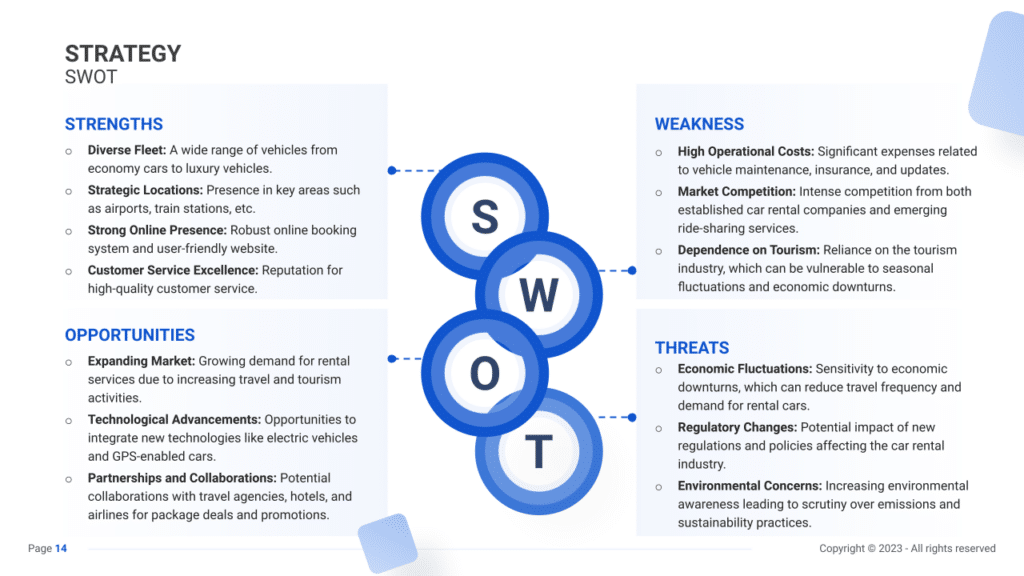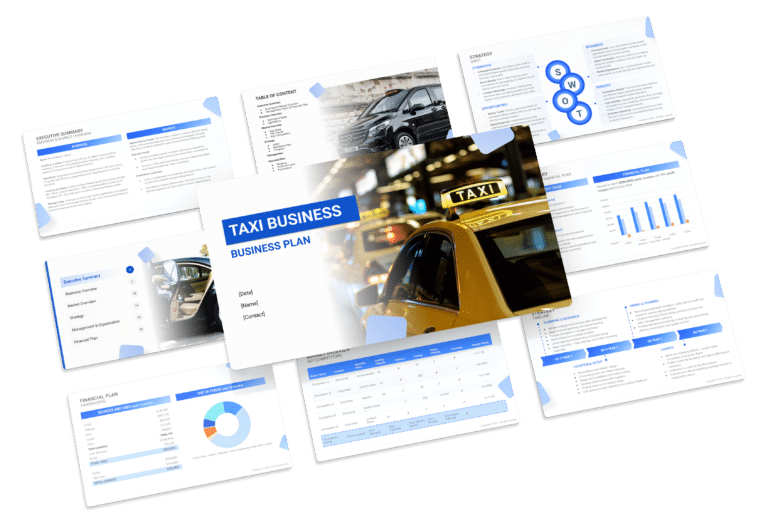SWOT Analysis for a Car Rental Company (Example)

Creating a business strategy for a car rental company involves doing a SWOT analysis. SWOT stands for Strengths, Weaknesses, Opportunities, and Threats. It helps owners evaluate their business thoroughly, looking at internal factors they can control and external factors that affect their operations.
In a business plan, SWOT analysis highlights the car rental company’s market position and identifies growth opportunities and areas needing improvement. Strengths could be a varied fleet, good customer service, and convenient locations. Weaknesses might include reliance on seasonal demand or issues with vehicle maintenance.
This article will discuss different strengths and weaknesses, helping car rental company owners use these insights in their business planning.

Strengths
- Fleet Diversity: Offering a wide range of vehicles caters to diverse customer needs, enhancing the appeal of your car rental service.
- Example: A fleet featuring economic, luxury, and eco-friendly options attracts a broad customer base.
- Convenient Locations: Strategic placement of rental stations in high-traffic areas provides accessibility and convenience to customers.
- Example: Having outlets near airports and major transport hubs maximizes customer reach.
- Tech Integration: Utilizing advanced reservation systems and mobile apps streamlines the booking process, providing a seamless customer experience.
- Example: Implementing a user-friendly mobile app for bookings enhances customer satisfaction and loyalty.
- Brand Reputation: A positive brand image and customer reviews contribute to trust and influence the decision-making process.
- Example: Showcasing positive testimonials on your website builds credibility and attracts potential customers.
Weaknesses
- Aging Fleet: An outdated fleet can lead to higher maintenance costs, potential breakdowns, and a diminished customer experience.
- Example: Regularly updating the fleet ensures reliability and customer satisfaction.
- Limited Geographic Presence: Operating in only a few locations may restrict market reach and limit the customer base.
- Example: Expanding to popular tourist destinations can unlock new revenue streams.
- Dependence on Seasonal Trends: Relying heavily on seasonal demand can lead to fluctuations in revenue and resource management challenges.
- Example: Diversifying services, such as offering long-term rentals, helps maintain consistent income.
- Online Security Concerns: Inadequate cybersecurity measures may pose risks to customer data, damaging trust and reputation.
- Example: Investing in robust cybersecurity measures protects customer information and enhances trust.
Opportunities
- Eco-Friendly Initiatives: Embracing environmentally friendly practices, such as electric or hybrid vehicles, aligns with the growing demand for sustainable options.
- Example: Introducing a green fleet attracts environmentally conscious customers and aligns with market trends.
- Partnerships with Airlines or Hotels: Collaborating with travel-related businesses can enhance visibility and create mutually beneficial partnerships.
- Example: Offering joint promotions with airlines or hotels increases cross-promotional opportunities.
- Digital Marketing: Leveraging online platforms and social media for marketing can significantly expand your customer reach.
- Example: Running targeted online campaigns can attract a younger demographic and boost reservations.
- Specialized Packages: Introducing tailored packages for events or niche markets can attract a diverse customer base.
- Example: Offering wedding or corporate event packages can tap into specialized markets and boost bookings.
Threats
- Intense Competition: A saturated market may lead to price wars and reduced profit margins.
- Example: Emphasizing unique services like doorstep delivery or exclusive loyalty programs differentiates from competitors.
- Regulatory Changes: Evolving regulations in the rental industry can pose challenges and require continuous adaptation.
- Example: Regularly updating policies and procedures ensures compliance with changing regulations.
- Economic Downturns: Economic uncertainties can impact travel, leading to reduced demand for car rental services.
- Example: Implementing flexible cancellation policies can mitigate the impact of economic downturns on reservations.
- Technological Disruptions: Rapid advancements in autonomous vehicles or ride-sharing technologies may disrupt traditional car rental models.
- Example: Investing in research and development to integrate new technologies keeps your business at the forefront.





